Blanowice Formation
The Blanowice Formation is a geologic formation in Częstochowa, Poland. It is late Pliensbachian-Lowermost Toarcian age.[1][2][3] Vertebrate fossils have been uncovered from this formation, including tracks.[1] Along with the Drzewica Formation is part of the Depositional sequence IV-VII of the late lower Jurassic Polish Basin, with the IV showing the presence of local Alluvial deposits, with possible meandriform deposition origin, dominated in Jagodne and Szydłowiec, while delta system occurred through the zone of the modern Budki.[1] Deposits of sequences IV, V, VI and VII make up the Blanowice Formation, being all four sequences are of Pliensbachian age, documented by megaspores (Horstisporites).[1] On the upper strata, “sub-coal beds" cover the sequence VII-lower VIII (Pliensbachian-Toarcian transition), while the uppermost part of VIII is identified with the Ciechocinek Formation.[1] The Blanowice Formation has been know for decades thanks to the abundant Plant fossils and plant roots, but mostly due to the Blanowice Brown Coals[4][5], where the oldes Biomolecules found worldwide have been recovered.[6] The Mrzygłód mine dinocyst assemblage is taxonomically un diversified, containing specimens that are good age indicators al lowing relatively precise suggestion of its age.[3] Luehndea spinosa, with a single recovered specimen spans between the Late Pliensbachian (Margaritaus) to the Lowermost Toarcian (Tenuicostatum). Other ocal dinocysts such as Mendicodinium range Late Pliensbachian–Aalenian, a wider stratigraphic range.[3] The lower part of the formation is coeval in age with the Gielniów Formation and Drzewica Formation (Southern and central Poland), Lobez Formation and Komorowo Formation (Pomerania), Olsztyn Formation (Baltic German-Polish transition), the lower part of the Rydeback Member of the Rya Formation (Southern Sweden), lower Fjerritslev or Gassum Formation (Danish Basin), lower and middle Bagå Formation (Bornholm), Neringa Formation (Lithuania).[1] The Upper part is coeval with the lowermost upper Rydeback Member, upper Gassum Formation and lower Lava Formation (Lithuania).[1]
| Blanowice Formation Stratigraphic range: Late Pliensbachian to Lower Toarcian ~183 Ma [1] | |
|---|---|
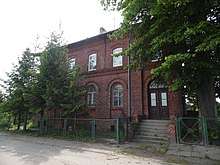 Main Building of the Wysoka mine, where plants and strata from the formation have been found. | |
| Type | Geological formation |
| Unit of | Kamienna Group[1] |
| Sub-units |
|
| Underlies | Ciechocinek Formation, Borucice Formation[1] |
| Overlies | Zagaje, Lobez, Ostrowiec & Gielniów Formations |
| Thickness | Up to ~42.0 m (137.8 ft)[1] |
| Lithology | |
| Primary | Sandstones, subordinately Mudstones, Heteroliths y Coal seams. |
| Other | Several types of heteroliths and mudstones |
| Location | |
| Region | Szydłowiec, Southern Poland |
| Country | |
| Extent | Czêstochowa region[1] |
| Type section | |
| Named for | Blanowice, a town from Zawiercie, Poland |
| Named by | Znosko (as an informal unit)[2] |
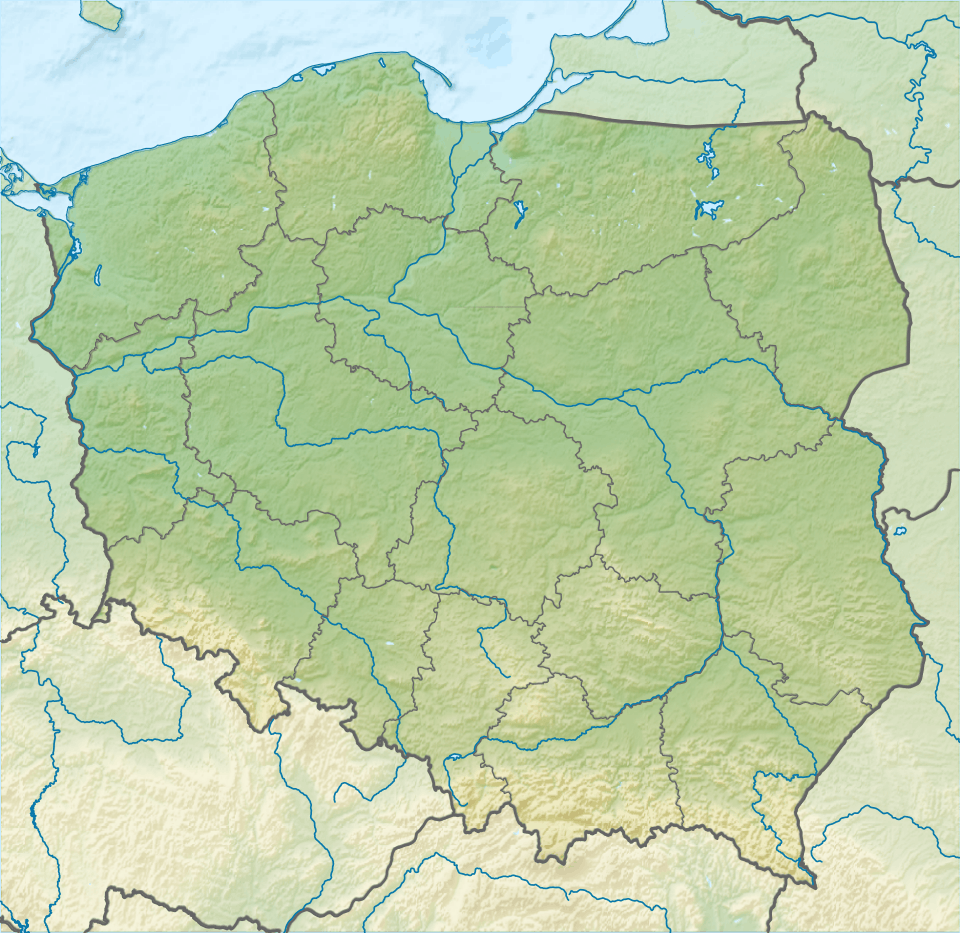 Blanowice Formation (Poland) | |
Mining
.jpg)
The local Mesozoic brown Coal is composed by Lignite of Lower Jurassic age, known as the Blanowice Coal. Increased carbon-bearing capacity, locally present in the profile of the Upper Forest land sediments, was the basis for the development coal mining in this area in the years 1818–1959. The mining center at that time was concentrated in the vicinity of Poręba near Zawiercie, as well as in a dozen other towns (Sprawowice, Blanowice, Łazy, Siewierz). Its basis was shallow exploitation a coal seam with a thickness of up to 2.0 m.[7][8] Occurrence of Blanowice Coals in Jurassic outcrops between Częstochowa and Zawiercie was known for a long time. Already in the 1890s, they were mined on a small scale in the vicinity of Blanowice, being described since the start of the exploitation.[9] After 1796 on Siewiersk was reported hard coal, the first outcrop of the main Blanowice Fm coal. The mining of Blanowice Coals developed specially in the 1920s and 30s of the 20th century, where major discoveries where reported.[10] This coals where exploited on small exploitations, where various minor mines recovered the coal seams.[8] The "Zygmunt" mine, operating at the turn of the 1920s and 1930s, was one of the largest. Annual production, as shown in official documents, it exceeded the total output from other mines many times.[8]
Biota
.jpg)
The Blanowice Formation recovers a deltaic section on the eastern Bohemian Massif, where rivers come from the west, as proven by the Carboniferous fossil matter found on the layers of the formation, moved from the west of the Czech Republic, and deposited specially on the Parkoszowice borehole.[11] This Borehole shows enhanced biomass contribution from aquatic algae groups, that proves a more marine influence than on other coeval boreholes, such as the Brody-Lubienia.[11]
The Blanowice Formation Brown Coal has been know since 1800 from its abundant deposits, where younger material has been suggested as redeposited from this deposits.[12][6] The organic matter found includes the oldest known Biomolecules, that are composed by Labdanoic Acid, Ferruginol, Sugiol and 7-Oxototarol, from the “Blanowice brown coals”.[13] These coals are generally dominated by Vitrain macerals, with exceptions where there is a greant porcentage of Inertinite. This lead ot interpret as a result of wildfire or peat fire activity, confirmed by the co-occurrence of charcoal fragments.[13] Sesquiterpenoids and Diterpenoids where also recovered from the Coal, common in Conifers as well as in other plants such as angiosperms and bryophytes.[14] Vitrinite has local reflectance values of 0.49-0.56 %Ro. The Cupressaceae and/or Podocarpaceae families are considered the main peat-forming plant species (Due to the presence of phenolic Abietanes and dehydroabietic acids).[13] Posterior revision of the Lignites of the Brown Coals had revealed a major distribution of Benzohopane derivatives in these coals and surrounding sandstones, that implicate probable differences in the degree of Biodegradation, and also a low Coalification range, typical of Lignites.[15] Later largers studies cover a really big influence of the fires on the region.[16] After the Toarcian Anoxic Event on the called "Kaszewy-1" (Where the Toarcian makes ~150 m of the strata) the Wildfire activity was widely recorded.[16] The Structure of the main depositional setting has been seen divided in 3 parts: on the center, near Kaszewy Kościelne there was a major restricted brackish-marine basin, with seasonal influxes of marine water.[16] The great abundance of Charcoal is the main indicator of the fire activity locally, but also the Polycyclic Aromatic Hydrocarbons, whose abundance reflects an increase in wildfire activity.[16] Coarse Charcoal particles abundance is low, while the fine Charcoal particles are more abundant on nearly all the measured samples, vinculated to small reductions of the Sea Level locally.[16] The most abundant Polycyclic Hydrocarbon found locally is Phenanthrene, and along the Charcoal data shows how the Fires locally increased around the Carbon Isotope Excursion on the Toarcian Anoxic Event Worldwide.[16] Along this period, mostly of the strata of the region shows at least 6 periods of fire intensification, that are coeval to anothers found on Yorkshire, Wales and Peniche.[16]
Dinoflagellates
On the Mrzygłód mine samples there is a domain of land-derived phytoclasts and palynomorphs, with abundance of the cyst Nannoceratopsis, that is conidered an euryhaline genus.[3]High amount of terrestrial organic matter shows that there was an intense supply and accumulation of land-derived organic particles from surrounding land areas, what, along with the decrease of salinity conditions, thanks to the dinocysts conclude that the assemblage represents a part of the Blanowice Formation deposited in a proximal area under brackish conditions, with possible changes on the range of salinity.[3]
| Genus | Species | Location | Material | Notes | Images |
|---|---|---|---|---|---|
|
Nannoceratopsis[3] |
|
|
Dinocysts |
A Dinophyceae Dinoflagellatan, type member of the family Nannoceratopsiaceae. N. sp. A differs from all Nannoceratopsis, where they have antapical horns by the shape of con cavity between these horns this has triangular shape created by two straight in near margins of the horns. The large amount of Cysts of the genus point to more diversified marine palaeoenvironments. |
|
|
Batiacasphaera[3] |
|
|
Dinocysts |
A Dinophyceae Dinoflagellatan, member of the family Gonyaulacales. A rather rare genus present on a few samples. |
|
|
Mendicodinium[3] |
|
|
Dinocysts |
A Dinophyceae Dinoflagellatan, member of the family Gonyaulacales. A rather rare genus present on a few samples. |
|
|
Luehndea[3] |
|
|
Dinocysts |
A Dinophyceae Dinoflagellatan, type member of the family Luehndeoideae. Presence of Luehndea spinosa suggests Late Pliensbachian–earliest Toarcian age of studied assemblages. |
|
Palynology
The Blanowice Beds are distributed in area between Częstochowa, Dębnik, Siewierz and Olkusz in the Silesian - Cracow Monocline.[17] The coals were mined there in the years 1818-1959.[12] The major plant bearing strata is exposed at Kierszuła near Poręba, where a identified spore-pollen assemblage comprises higher cryptogamic plants (Bryopsida, Selaginellopsida, Sphenopsida, Lycopsida, Pteropsida) and the gymnospermous (Pteridospermopsida, Cycadopsida, Bennettitales, Ginkgoaceae, Coniferopsida).[17] The Pollen of coniferous plants has been seen as connected with the Cheirolepidiaceae group, on an assemblage of herbaceous peat-bog vegetation, characterized by predominance of ferns, was most probably the parent material for that variety of coals. The presence of fairly thick laminae of Vitrain in the Kierszuła middle layers indicates some phases with share of forest assemblage marked in area of contemporary peat-bog.[17][18]
| Genus | Species | Location | Material | Notes | Images |
|---|---|---|---|---|---|
|
Sporopollenites[19] |
|
|
Spores or Pollen |
Uncertain assigantion Palynological remains, that resemble both Pollen and Megaspores, with non diagnosed affinities. |
|
|
Rogalskaisporites[19] |
|
|
Spores |
Affinities with Sphagnopsida inside Sphagnales. Pollen nearly identical to that one found associated with the modern moss genus Sphagnum. Moss related to high humid environments. |
 Modern Sphagnum |
|
Leptolepidites[17] |
|
|
Spores |
||
|
Foveotriletes[17] |
|
|
Pollen |
||
|
Uvaesporites[19] |
|
|
Pollen |
Affinities with Selaginellaceae inside Lycopodiophyta. Spores that resemble that of Selaguinella-like herbaceous flora. |
|
|
Apiculatisporis[19] |
|
|
Pollen |
Affinities with Selaginellaceae inside Lycopodiophyta. Pollen nearly identical to that one found associated with the modern moss genus Selaginella. Herbaceous Fern related to high humid environments. |
 Modern Selaginella |
|
Densoisporites[17] |
|
|
Spores |
Affinities with Selaginellaceae inside Lycopodiophyta. Herbaceous Fern related to high humid environments. The species Densoisporites rugosus can be a junior synonym of Densosporites solaris |
|
|
Lygodiumsporites[19] |
|
|
Spores |
Affinities with Lygodiaceae inside Schizaeales. Spores nearly identical to that one found associated with the modern moss genus Lygodium. Climbing ferns, that grew over trees nad are Pyrofiles, fuel for peat fires, whose presence are widely recorded locally on the Blanowice Brown coals. |
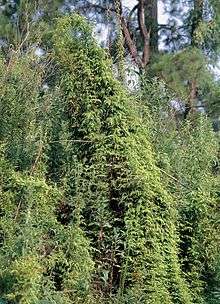 Modern Lygodium |
|
Reticulatisporites[19] |
|
|
Spores |
Affinities with Lygodiaceae inside Schizaeales. |
|
|
Carnisporites[17] |
|
|
Spores |
Affinities with the genus Cynepteris inside Cynepteridaceae . Floor Ferns related to high humid environments. |
|
|
Todites[19] |
|
|
Pollen |
Affinities with Polypodiopsida inside Pteridopsida. Pollen nearly identical to that one found associated with the fern leaf genus Todites or with Cladophlebis |
|
|
Osmundacidites[19] |
|
|
Spores |
Affinities with Osmundaceae inside Pteridophyta. Spores nearly identical to that one found associated with the modern fern genus Osmunda. Members of the genus Osmunda have been found on coeval age strata on Sweden. |
Modern Osmunda |
|
|
Spores |
Affinities with Marattiaceae inside Marattiales. spores nearly identical to that one found associated with the fern leaf genus Marattiopsis |
||
|
Marattisporites[17] |
|
|
Spores |
Affinities with Marattiaceae inside Marattiales. |
|
|
Concavisporites[19] |
|
|
Spores |
Affinities with Dipteridaceae inside Gleicheniales. Spores nearly identical to that one found associated with the fern leaf genus Clathropteris |
|
|
Cyathidites[19] |
|
|
Spores |
Affinities with Cyatheaceae inside Cyatheales. Cyathidites minor almost certainly belong to well known Mesozoic species Coniopteris hymenophylloides and to other fossil cyatheaceous or dicksoniaceous ferns such as Eboracia lobifolia and Dicksonia mariopteri. |
|
|
Chasmatosporites[19] |
|
|
Pollen |
Named originally Pollenites apertus, they resemble pollen grains of the genus Cycas. Later works refer them to modern pollen grains that proper of wrote that resemble ?Cycadopsida (?Cycadales). Alternatively, can be Pollen from members of Ginkgopsida (?Gnetales).[20] |
|
|
Bennettistemon[19] |
|
|
Spores |
Affinities with Bennettitales inside Bennettitopsida. Bennetitalean Spores, coming from hebaceous to arbustive plants. |
|
|
Pityosporites[19] |
|
|
Pollen |
Affinities with Pinaceae inside Coniferae. Resemble modern Pinus Pollen, probably belonging to a similar Genus. |
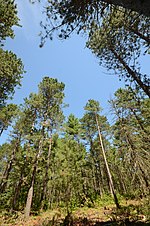 Modern Pinus |
|
Quadraeculina[19] |
|
|
Pollen |
Affinities with Pinaceae inside Coniferae. Pollen From arbustive to arboreal plants, resembling the pollen of the modern genus Picea |
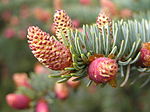 Modern Picea |
|
Tsugapollenites[19] |
|
|
Pollen |
Affinities with Abietoideae inside Coniferae. Pollen From arbustive to arboreal plants, resembling the pollen of the modern genus Tsuga |
Modern Tsuga |
|
Inaperturapollenites[19] |
|
|
Pollen |
Affinities with Abietoideae inside Coniferae. Diploxylonoid bisaccate pollen grains of Coniferales affinity |
|
|
Sciadopityspollenites[19] |
|
|
Pollen |
Affinities with Sciadopityaceae inside Coniferae. This pollen resembles the present on the modern Cupressaceae Sciadopitys |
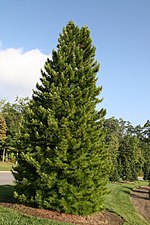 Modern Sciadopitys |
|
Podocarpeaepollenites[19] |
|
|
Pollen |
Affinities with Podocarpaceae inside Pinopsida. Pollen From arbustive to arboreal plants |
|
|
Pristinuspollenites[19] |
|
|
Pollen |
Affinities with Podocarpaceae inside Pinopsida. Pollen From arbustive to arboreal plants |
|
|
Pseudopodocarpus[19] |
|
|
Pollen |
Affinities with Podocarpaceae inside Pinopsida. Pollen From arbustive to arboreal plants |
|
|
Classopollis[20] |
|
|
Pollen |
Affinities with Cheirolepidiaceae inside Pinopsida. Cheirolepidaceae Pollen represents the 56 to 60 % of the Palynology of the Formation. |
|
|
Araucariacites[19] |
|
|
Pollen |
Affinities with Araucariaceae inside Pinopsida. Pollen From arbustive to arboreal plants |
|
Plant Remains
| Genus | Species | Location | Material | Notes | Images |
|---|---|---|---|---|---|
|
|
Leaves |
Affinities with Matoniaceae inside Gleicheniales. Leaves of medium-sized ferns, related to modern Matonia. This type of ferns are found on tropical-humid environments, where they form large-scale colonies with +1000 individuals. The genus Laccopteris was synonymized with Phlebopteris elegans. |
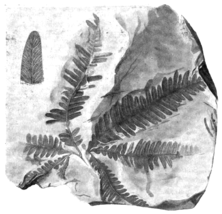 Fossil Phlebopteris | |
|
|
Leaves |
Affinities with Dipteridaceae inside Gleicheniales. Is a sister taxa to Hausmannia. It was identified by Rogalska (1954) as Pecopteris integrifolia.[19] Has been sugested as a possible member of the Ginkoales, as some Leaves have resemblance with the genus Baiera. It was also identified as Laccopteris elegans. Ferns with Coriaceous leaves, found on Tropical climates. |
||
|
|
Leaves |
Affinities with Lyginopteridaceae inside Pteridospermatophyta. A genus of leave related to the older Lyginopteris and Macroneuropteris. It belongs to medium to large arboreal fern-like plants. |
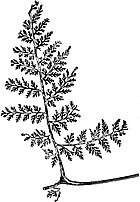 Reconstruction of Sphenopteris | |
|
|
Seed cones |
Affinities with Czekanowskiales inside Ginkgoaceae. Reproductive organs related with Pollen, from Arboreal Plants Similar to modern Ginko. Leptostrobus is considered as a reproductive organ of Czekanowskia and assigned to Czekanowskiales because of the association of Leptostrobus and Czekanowskia in several localities and theagreement in their structures of basal scale leaves and cuticles. |
||
Fungi
| Genus | Species | Location | Material | Notes | Images |
|---|---|---|---|---|---|
|
Indeterminate |
|
Fungal spores of different sizes associated with wood |
Associated with a high rate of organic burial, the presence of Fungal Matter increased on the Uppermost layers of the Pliensbachian Drzewica Formation, with a continue deposition between the T-OAE extincion, and several ups and downs on the Ciechocinek Strata, related with local climate and humidity changes. This is rather a reflection of the efficiency of terrestrial biodegradation.[23] Measured increasing of temperature favoured local fungal-mediated decomposition of plant litter, specifically of normally resistant wood.[23] |
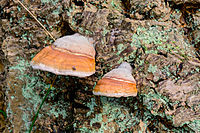 Xylophagous Fungi like Fomitopsis are probably the main origin for the Fungal Spores found on the Blanowice Formation | |
|
Sporonites[19] |
|
|
Spores |
Fungal Spores with non diagnosed affinities, probably related with Pucciniomycetes inside Agaricomycotina. It is found associated with Pollen and Spores, interpreted as some sort of parasitism. |
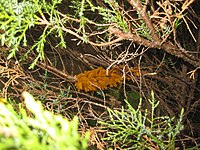 Sporonites was probably related with plant parasite fungus, such as Gymnosporangium |
Bivalvia
| Genus | Species | Location | Material | Notes | Images |
|---|---|---|---|---|---|
|
Cardinia[24] |
|
|
Shells |
A bivalve clam, Type genus of the family Cardiniidae inside Carditida. On the Pliensbachian strata there isn´t a clear consensus if the Polish Basin reached stenohaline conditions, but the presence of this genus on the Parkoszowice 58 BN borehole along with foramiferans and marine phytoplankton tends to support more polyhaline-mesohaline conditions.[25] |
|
References
- Pieñkowski, G. (2004). The epicontinental Lower Jurassic of Poland. Polish Geological Institute Special Papers, 12, 1-154.
- ZNOSKO J., 1955 — Rhaetic and Lias between Cracow and Wieluñ [Eng. Sum.]. Pr. Inst. Geol., 14: 1–146
- Gedl, P. (2007). Early Jurassic dinoflagellate cysts from the Kraków-Silesia Monocline, southern Poland: a record from the Blanowice Formation at Mrzygłód. In Annales Societatis Geologorum Poloniae (Vol. 77, No. 2, pp. 147-159).
- Piwocki, M. (1983). Brown coals in Poland: characteristic of occurrence. Przegląd Geologiczny, 31(6), 364-370.
- Pierwoła, J., Badera, J., & Mirkowski, Z. (2011). Identification of geotechnical conditions in areas of former shallow mining activity using geoelectrical methods. In Geophysics in Mining and Environmental Protection (pp. 91-100). Springer, Berlin, Heidelberg.
- Sass-Gustkiewicz, M., & Kwieciǹska, B. (1994). Humic-sourced organic matter from the Upper Silesian Zn Pb deposits (Poland). International journal of coal geology, 26(3-4), 135-154.
- Wójcik, A. J., & Preidl, W. (2014). Węgiel blanowicki–zarys historii rozpoznania i eksploatacji do 1870 roku. Hereditas Minariorum, 1, 29-45.
- Wójcik, A. J., & Preidl, W. (2015). Kopalnia węgla blanowickiego „Zygmunt” w Porębie koło Zawiercia. Hereditas Minariorum, 2.
- ŁABĘCKI H., 1841. Górnictwo w Polsce. Opis kopalnictwa i hutnictwa polskiego, pod względem technicznym, historyczno-statystycznym i prawnym, 1. Drukarnia J. Kaczanowskiego. Warszawa
- DRATH A., 1935. Węgiel brunatny kopalni giel brunatny kopalni „Zygmunt” w Porębie obok Zawiercia. Akad. Nauk Techn.,Warszawa.
- Ruebsam, W., Pieńkowski, G., & Schwark, L. (2020). Toarcian climate and carbon cycle perturbations–its impact on sea-level changes, enhanced mobilization and oxidation of fossil organic matter. Earth and Planetary Science Letters, 546, 116417.
- LILPOP J. 1917. Mikroskopisch-anatomische Untersuchungen der Mineralkohlen. Bull. Acad. Sci. Crac.,Sci. Math. Nat., Ser. B: Sci. Nat., 1917: 6–24
- Rybicki, M., Marynowski, L., Misz-Kennan, M., & Simoneit, B. R. T. (2016). Molecular tracers preserved in Lower Jurassic “Blanowice brown coals” from southern Poland at the onset of coalification: Organic geochemical and petrological characteristics. Organic Geochemistry, 102, 77–92. doi:10.1016/j.orggeochem.2016.09.012
- RYBICKI, M., MARYNOWSKI, L., & SIMONEIT, B. R. (2015): Sesquiterpenoids and diterpenoids from Lower Jurassic sub-bituminous coal from the “Blanowice Formation”, southern Poland. In XXII nd Meeting of the Petrology Group of the Mineralogical Society of Poland (p. 87).
- Rybicki, M., Marynowski, L., & Simoneit, B. R. (2017). Benzohopane Series, Their Novel Di-, Tri-, and Tetraaromatic Derivatives, and Diaromatic 23-and 24-Norbenzohopanes from the Lower Jurassic Blanowice Formation, Southern Poland. Energy & Fuels, 31(3), 2617-2624.
- Pointer, R. (2019). Fire & Global Change During Key Intervals of the Late Triassic & Early Jurassic with a Focus on the Central Polish Basin.
- DOMAGAŁA M. & KOŁCON I. 1983. Zbiorowiska roślinności węglotwórczej liasowego węgla brunatnegoz Poręby koło Zawiercia (summary: Vegetation assemblages forming Lias brown coals in the Poręba area near Zawiercie). Kwart. Geol., 27(3): 503–516.
- PIEŃKOWSKI G. 1988. Analiza facjalna najwyższego triasu i liasu Wyżyny Krakowsko-Wieluńskiej oraz perspektywy występowania surowców ilastych.Przegl. Geol., 36(8): 449–456
- Rogalska,M. (1954) Spore and pollen analysis of the Liassic Coal of Blanowice in Upper Silesia [ Analyza sporowo-pylkowa Liasowego Wegla Blano-Wickiego z Gornego Slaska ] Biuletyn - Instytutu Geologiczny Vol. 89 P. 1- 46
- Ziaja, J. (2006). Lower Jurassic spores and pollen grains from Odrowąż, Mesozoic margin of the Holy Cross Mountains, Poland. Acta Palaeobotanica, 46(1), 3-83.
- RUTKOWSKI F. 1923. Sprawozdanie tymczasowez badań wykonanych na obszarze występowania węgla brunatnego w okolicach Zawiercia i Siewierza (summary: Preliminary report on the geology of the Zawiercie – Siewierz coal-field). Spraw. Pol.Inst. Geol. (Bull. Ser. Géol. Pol.), 2(1,2): 117–150.
- Pacyna, G. (2013). Critical review of research on the Lower Jurassic flora of Poland. Acta Palaeobotanica, 53(2), 141-163.
- Pieńkowski, G., Hodbod, M., & Ullmann, C. V. (2016). Fungal decomposition of terrestrial organic matter accelerated Early Jurassic climate warming. Scientific reports, 6, 31930.
- Dayczak-Calikowska, K., Kopik, J., & Marcinkiewicz, T. (1997). Middle Jurassic. Epicontinental Permian and Mesozoic in Poland: Prace Państwowego Instytutu Geologicznego, 153, 236-282.
- Kilhams, B., Kukla, P. A., Mazur, S., McKie, T., Mijnlieff, H. F., van Ojik, K., & Rosendaal, E. (2018). Mesozoic resource potential in the Southern Permian Basin area: the geological key to exploiting remaining hydrocarbons whilst unlocking geothermal potential. Geological Society, London, Special Publications, 469(1), 1-18.